![]()
![]()
![]()
Use LEFT and RIGHT arrow keys to navigate between flashcards;
Use UP and DOWN arrow keys to flip the card;
H to show hint;
A reads text to speech;
69 Cards in this Set
- Front
- Back
|
List the 5 major (classes/isotypes) of immunoglobulins?
|

Note the heavy chains associated with each Ig.
|
|
|
Which immunoglobulin (Ig) is most common in blood?
|
IgG
|
|
|
Which Ig is the "first responder" or always secreted first in an immune response?
|
IgM
|
|
|
Draw the general structure of an antibody. Indicate/describe: the antigen binding sites, N-termini, C-termini, light chains, heavy chains, variable region, constant region, and hinge region.
|
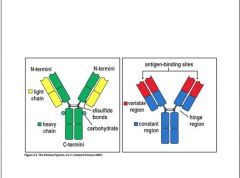
Antibodies are made from 4 polypeptides--2 heavy chains and 2 light chains which are linked by disulfide bonds. N-termini contains the variable (V) region, including the antigen binding site, which is reason for diverse antigen binding specificity. C-termini contain the constant region which binds to other body cells, and hinge region (on select Igs).
|
|
|
What are the 3 main antibodies present in blood, lymph and connective tissue?
|
IgM, IgA, IgG
|
|
|
Describe the role of IgG
|
Main function is to facilitate engulfment and destruction of extracellular microorganisms/toxins by phagocytes (aka opsonization). Also works in concert with complement. It has the longest has the longest half life in blood.
|
|
|
What immunoglobulin triggers immune hypersensitivity reaction (in developed countries)?
|
IgE. Its constant region binds tightly to mast cell receptors triggering strong inflammatory response (i.e. to parasitic worms or other organisms).
|
|
|
What 2 immunoglobulins are expressed as cell surface receptors on circulating naive B-lymphocytes?
|
IgM and IgD
|
|
|
What is lipopolysaccharide (LPS)? What effects does it have in the immune system, both locally and systemically?
|
LPS is major cell-surface component of gram negative bacteria and an endotoxin. Local infection stimulates acute inflammatory response (increased vascular permeability, WBC infiltration, and swelling). Systemic infection induces fever, headache, vomiting and septic shock. Septic shock decreases BP and cardiac output. It may also lead to DIC and/or ARDS.
|
|
|
Describe the structure of LPS noting its antigenic and endotoxic components.
|
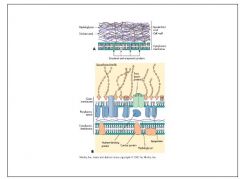
LPS has a hydrophobic lipid-rich end and a hydrophilic polysaccharide-rich end which is antigenic and a determinant of the O antigen. The endotoxicity of the molecule resides in Lipid A region.
|
|
|
Describe the characteristics of LPS endotoxin that make it difficult to get rid of (cleanly remove).
|

|
|
|
Describe the key immune system mediators in response to LPS endotoxin and their primary effects. Which three are most critical?
|
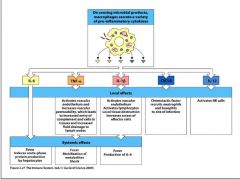
Most critical: TNF, IL-1, and IL-6
|
|
|
Describe the interrelated effects of the 3 key mediators (trio) in the endotoxic immune response.
|
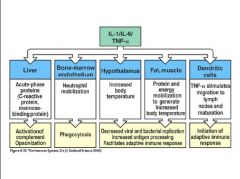
|
|
|
List the primary and secondary immune organs.
|
Primary: Bone marrow, Thymus; Secondary: Spleen, Lymph nodes, Tonsils/adenoids, Peyers patches, appendix.
|
|
|
Describe the major cell types involved in immune response.
|
B cell: a lymphocyte derived from lymphoid precursor; differentiates into plasma cells that secrete antibody upon infection; T cell: regulates the immune response, kills infected cells; Macrophage: phagocytic cell resident in tissues that kills foreign particles; Monocyte: a macrophage equivalent that circulates in blood--becomes a macrophage when it enters tissue. PMNs: neutrophils engaged in phagocytosis of foreign particles. These make up large portion of WBC. Eosinophils: important for killing worms--with major basic protein. Basophil: unknown function; Mast cell: release of histamine.
|
|
|
Define the lag (aka inductive or latent) phase of the (antibody) immune response.
|
The lag or latent phase is the period of time after initial exposure to an immunogen before antibody can be detected.
|
|
|
Describe the primary and secondary immune response in terms of antibody production phases.
|
After exposure to a immunogen, there is a lag phase followed by a exponential increase in pathogen-specific antibody. This antibody production reaches a peak and then plateaus (steady state). The steady state period is followed by a steady decline or decay of antibody in the serum. Upon secondary exposure to the immunogen (or vaccine), there is a significantly shorter lag time and more robust pathogen-specific antibody production. This is called the secondary or "memory" response.
|
|
|
List the 7 ways that the secondary immune response differs from the primary immune response.
|
1. Shorter lag time
2. Higher rates of antibody synthesis 3. Higher peak antibody titer 4. Longer persistence of antibody 5. A predominance of IgG class molecules 6. Higher affinity of antibody 7. Requires less antigen |
|
|
Describe the B-lymphocyte repertoire.
|
The B-cell repertoire consists of individual B-cells that express only 1 of many idiotypes (variable region) of immunoglobulin on their surface. The collection of B-cells expressing different Igs constitute the full repertoire of antibody specificities.
|
|
|
Describe the process of clonal selection in B-cells.
|
When naive B-cells encounter an antigen that corresponds to its surface bound Ig it binds and is then activated with T-cell help. This causes the B-cells to proliferate (making daughter cells) and also differentiate into plasma cells that secrete antibody. As immune response continues, there is increasing selection of those B-cells that have the highest affinity for antigen (and thus a higher antibody specificity).
|
|
|
Helper T-cells are distinguished by what surface antigen?
|
CD4
|
|
|
What is a hapten?
|
A small molecule that cannot induce an antibody response on its own. It may induce a response when it is bound to a carrier protein.
|
|
|
Describe the differences in how B-cells vs. T-cells view/interact with antigens.
|
T-cells mostly react to antigens that are proteins or peptides. They will react with the antigen of the surface of antigen presenting cells or with MHC and co-stimulatory molecules. Once activated they will proliferate and then stimulate B-cells. B-cells may recognize/mount antibody response to a protein carrier or a hapten. Once activated by T-cells, B-cells may differentiate into plasma cells or memory cells; Other T-cell factors cause the switch from IgM to IgG production.
|
|
|
What are T-independent antigens? What types of molecules are part of this class?
|
T-independent antigens are immunogens that do not require T-cell help to produce and immune response. These are usually polymeric molecules with a large number of repeating subunits that can cause cross-linking of the Ig on the B-cell. They may also be polyclonal activators of B-cells that provide a mitogenic signal to the B-cell ( thought to work through TLRs).
|
|
|
What is an antigen presenting cell (APC)? What features or actions are required for a cell to be considered an APC?
|
APC function is to intiate interaction with antigen via endocytosis, phagocytosis or interaction with complement (C3b receptor mediated or preexisting), or receptors. APC process the antigen (digest) and then present its fragment on the cell surface with MHC class II antigens. Additionally, the APC must express MHC class II antigens on its surface, provide a second or co-stimulatory signal (B7). Note: B-cells can do these things too.
|
|
|
Which cells are considered excellent antigen presenting cells?
|
Dendritic cells, Langerhans cells, mononuclear phagocytic cells.
|
|
|
List the 5 most important ROS inclusive of the RNOS. Which ones are primary and which are secondary. Draw the chemical structure for each. Which ones are free radicals.
|
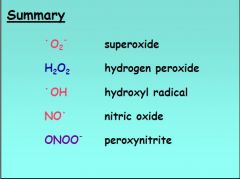
Primary ROS: Superoxide and Nitric oxide (primary RNOS). The others are secondary ROS.
|
|
|
Write the metabolic synthesis rxns for the following ROS: superoxide.
|
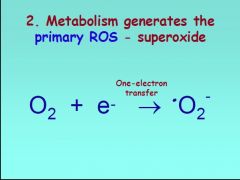
|
|
|
Write the metabolic synthesis rxns for the following ROS: Nitric oxide.
|

|
|
|
List the 13 vitamins and their common names.
|

|
|
|
List the fat soluble vitamins.
|
Vitamins: A, D, E, K
|
|
|
List the water soluble vitams.
|
Vitamins: B1, B2, B3, B5, B6, B9, B12, Biotin, C
|
|
|
Vitamins are classified according to absorption/transport and not function. For each of the listed fat-soluble vitamins, indicated key classification features: A, D, E, K.
|
Vitamin A: chromophore, hormone, antioxidant; Vitamin D: hormone; Vitamin E: antioxidant; Vitamin K: coenzyme involved in carboxylation, calcium and clotting.
|
|
|
Vitamins are classified according to absorption/transport and not function. For each of the listed water-soluble vitamins indicate key classification features: C, B complex (B1-3, B5-6, B9, B12), Biotin.
|
Vitamin C: antioxidant, a collagen/cross-linking cofactor; Vitamin B1-3, B5-6, Biotin: energy releasing (oxphos)
Vitamin B9, B12: hematopoietic |
|
|
List the primary functions for each of the fat-soluble vitamins? Note the deficiencies associated with each.
|
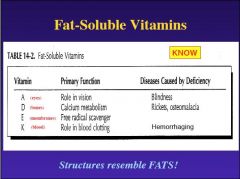
Vitamin A: deficiency results in night blindness and keratomalacia (softening of cornea); Vitamin E: deficiency results in damage to cell membranes, leakage of cell contents leading to myopathies, neuropathies, and liver necrosis but no MAJOR disease. Note: preemies/LBW and those with fat malabsorption predisposed to Vit E deficiency. Vitamin K: deficiency associated with increased prothrombin time and easy bruisability. Note Vitamin antagonists are anticoagulants.
|
|
|
List the associated functions/enzymes for each of the water soluble vitamins. Note the deficiencies associated with each.
|

|
|
|
Summarize the key functions of Vitamin A.
|

|
|
|
What are the precursors for vitamin A? What are the main derivatives of the Vitamin A family? Which of the derivatives is active in vision? Which of the derivatives is active gene transcription for growth/development?
|

|
|
|
What are the key functions of Vitamin D?
|

|
|
|
What are the 2 inactive provitamins of Vitamin D? Describe their conversion to active Vitamin D.
|

|
|
|
List the 3 major macrominerals.
|
Calcium, Magnesium, and Phosphorous
|
|
|
List the 9 microminerals.
|
Chromium, Copper, Cobalt, Fluorine (aka Fluoride), Iodine, Iron, Manganese, Molybdenum, Selenium, and (Zinc).
|
|
|
List the 4 hormones that regulate calcium homeostasis. Indicate their primary roles in maintaining this homeostasis.
|
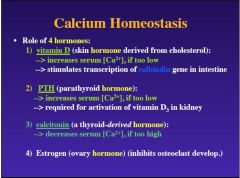
|
|
|
Describe the mechanism of calcium homeostasis, specifically the action of the 4 regulatory hormones.
|

|
|
|
What is the significance of Chromium (Cr) to metabolism?
|

|
|
|
Describe how copper deficiency leads to anemia. Compare/contrast to iron-deficiency anemia.
|

|
|
|
How are minerals classified in terms of daily allowance?
|
Macrominerals:> 100-200 mg per day required;
Microminerals: <100-200 mg per day required. |
|
|
Describe the general biologic function of minerals.
|
Participate in metal ion catalysis (many are metal ions);
-Facilitate nucleic acid stabilization (esp. Mg+) -Assist with protein folding (i.e. zinc fingers) |
|
|
List the 15 essential minerals and for each indicate its function(s) and any diseases that result from deficiency.
|

|
|
|
Describe the role and effects of calcium in the body.
|

|
|
|
Describe the absorption and transport of dietary calcium.
|
Calcium is absorbed in the intestines by active transport. Vitamin D is required for via calcium binding protein, calbindin.
|
|
|
Describe the process of bone remodeling by osteoblasts and osteoclasts and role of the major calcium-related hormones.
|

|
|
|
Define the differences between osteoporosis and osteomalacia.
|
Osteoporosis: mineralization is normal, bone mass reduced.
Osteomalacia: mineralization is reduced, bone mass is normal. |
|
|
List the dietary sources of Vitamin D? Where is Vitamin D stored in the body?
|
Vitamin D is obtained from fortified dairy products and oily fish. Most vitamin D, however, can be obtained from the action of sunlight on provitamins in the skin. Vitamin D is stored in fat depots throughout the body.
|
|
|
Describe/characterize the Vitamin D deficiencies: Rickets (in children) and osteomalacia (adults).
|
Rickets is a disorder of cartilage cell growth and enlargement of the epiphyseal growth plates and accumulation of undermineralized bone matrix giving soft, pliable bones (i.e. bowing of knees). Osteomalacia is a demineralization of preexisting bone that results in softer bones more susceptible to fracture.
|
|
|
What is the result of Vitamin D toxicity (>50,000 IU per day).
|
Very high serum calcium that leads to aberrant calcification of soft tissues (i.e. formation of kidney stones which can lead to kidney failure).
|
|
|
What is the biologic role of Vitamin E? Where is it found in the body? Major dietary sources?
|
Vitamin E acts as an antioxidant-- a free radical scavenger (alpha tocopherol is potent ROS scavenger). It also prevents oxidation of LDL, thereby helping to reduce risk of CVD. Vitamin E is found in cell membranes, circulating lipoproteins and fat deposits (mostly). Dietary sources: vegetable oils.
|
|
|
List the 2 key members of the Vitamin E family(there are 8 naturally occuring forms). Which is the form that is actively maintained in the body? Which 2 homologs are the major forms found in blood plasma.
|

|
|
|
Deficiencies in Vitamin E result in what types of problems?
|
Damage to cell membranes, leakage of cell contents resulting in myopathies, neuropathies and liver necrosis. No major Vitamin E deficiency is know. Note: preemies and persons with fat malabsorption are predisposed to Vitamin E deficiency.
|
|
|
What are contraindications to Vitamin E supplementation?
|
Large doses of Vitamin E can interfere with Vitamin K metabolism during anticoagulant therapy and this increases risk for bleeding.
|
|
|
What is the biological function of Vitamin K?
|
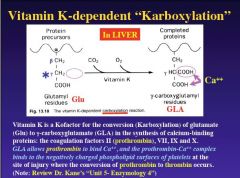
Vitamin K is crucial for blood clotting. It is a cofactor for the conversion of glutamate residue to carboxyglutamate residue in the synthesis of calcium binding proteins including coagulation factors: II (prothrombin), VII, IX, and X. Factor II (prothrombin) synthesis occurs in liver and is proenzyme of thrombin.
|
|
|
Dietary sources of Vitamin K? How is it produced, absorbed and stored/found in the body? What are the 2 naturally occurring forms?
|
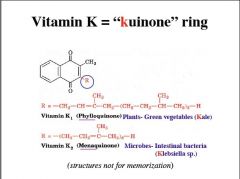
Vitamin K is absorbed in the small intestine and incorporated into chylomicrons, and distributed to tissues via low density lipoproteins. It is present in tissues in small amounts and there is little long-term storage. Naturally occuring forms: Vit K1 and Vit K2.
|
|
|
What are the symptoms/signs of Vitamin K deficiency?
|
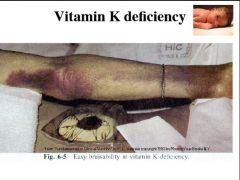
Vitamin K deficiency leads to increased prothrombin time which is associated with easy bruisability. Recall Vitamin K antagonists are given in anticoagulant therapy to prevent thromboembolism.
|
|
|
What is the recommended dietary intake of Vitamin K?
|
There is no recommended allowance for Vitamin K because of the variable contribution from the diet and intestinal synthesis.
|
|
|
List the 9 water-soluble vitamins and give their common names, cofactor form and diseases caused by their deficiency.
|

|
|
|
Why are the B-complex vitamins considered a complex?
|
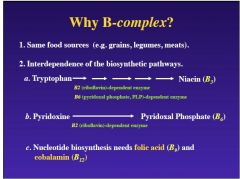
|
|
|
What is the biologic role of vitamin C (aka ascorbate)?
|
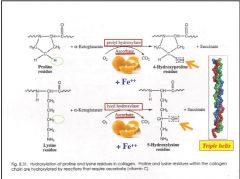
Vitamin C is a strong reducing agent, an antioxidant, and a cofactor in hydroxylation reactions. It is a required cofactor for enzymes that catalyze the hydroxylation of proline and lysine residues during-collagen synthesis (cross linking).
|
|
|
What are the dietary sources of vitamin C? How is it absorbed?
|
Fruits and veggies; It is absorbed by a sodium dependent mechanism.
|
|
|
Deficiency in Vitamin C leads to what disease? What are the common signs of the disease?
|
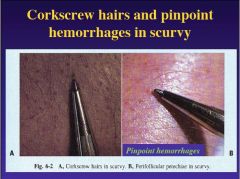
Scurvy; it is a defect in collagen synthesis. Symptoms: corkscrew hairs, impaired wound healing, malformed teeth, and capillary rupture.
|

